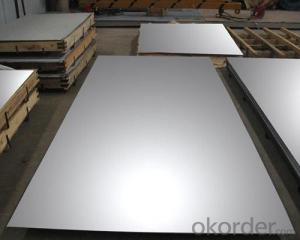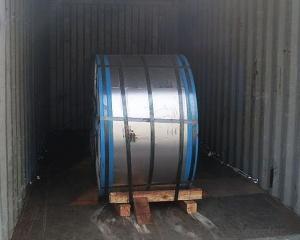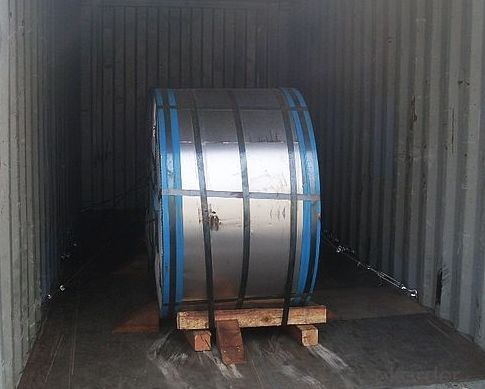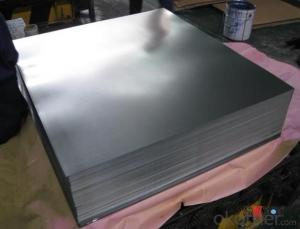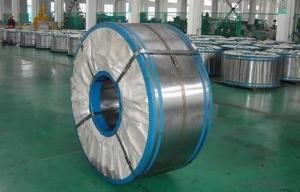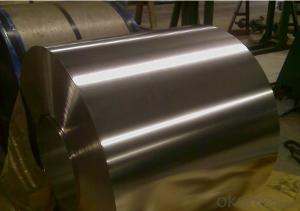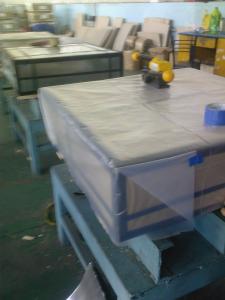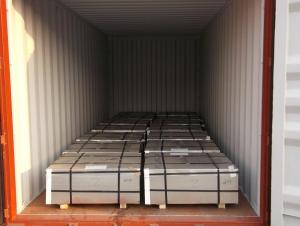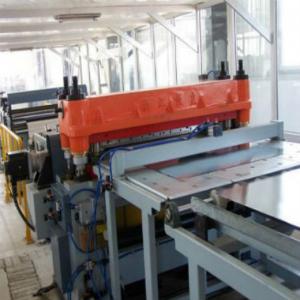Tinplate Coils / Sheet for Foods Can Packaging
- Loading Port:
- Tianjin
- Payment Terms:
- TT OR LC
- Min Order Qty:
- 25 m.t
- Supply Capability:
- 7000 m.t/month
OKorder Service Pledge
OKorder Financial Service
You Might Also Like
1.Structure of Electrolytic Tin Plate Coils and Sheets for Foods Metal Packaging Description
Electrolytic Tin Plate Coils and Sheets for Foods Metal Packaging, is one thin steel sheet with a coating of tin applied by electrolytic deposition. Tinplate made by this process is essentially a sandwich in which the central core is strip steel. This core is cleaned in a pickling solution and then fed through tanks containing electrolyte, where tin is deposited on both sides. As the strip passes between high-frequency electric induction coils, it is heated so that the tin coating melts and flows to form a lustrous coat.
2.Main Features of the Electrolytic Tin Plate Coils and Sheets for Foods Metal Packaging
Appearance – Electrolytic Tin Plate is characterized by its beautiful metallic luster. Products with various kinds of surface roughness are produced by selecting the surface finish of the substrate steel sheet.
Paintability and printability – Electrolytic Tin Plates have excellent paintability and printability. Printing is beautifully finished using various lacquers and inks.
Formability and strength – Electrolytic Tin Plates have got very good formability and strength. By selecting a proper temper grade, appropriate formability is obtained for different applications as well as the required strength after forming.
Corrosion resistance – Tinplate has got good corrosion resistance. By selecting a proper coating weight, appropriate corrosion resistance is obtained against container contents. Coated items should meet 24 hour 5 % salt spray requirement.
Solderability and weldability – Electrolytic Tin Plates can be joined both by soldering or welding. These properties of tinplate are used for making various types of cans.
Hygienic – Tin coating provides good and non toxic barrier properties to protect food products from impurities, bacteria, moisture, light and odours.
Safe – Tinplate being low weight and high strength makes food cans easy to ship and transport.
Eco friendly – Tinplate offers 100 % recyclability.
Tin is not good for low temperature applications since it changes structure and loses adhesion when exposed to temperatures below – 40 deg C.
3.Electrolytic Tin Plate Coils and Sheets for Foods Metal Packaging Images
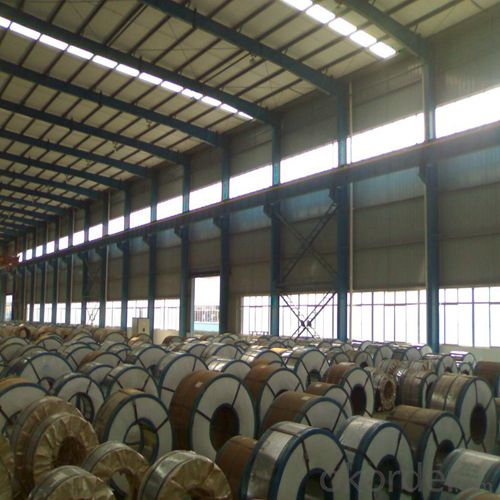
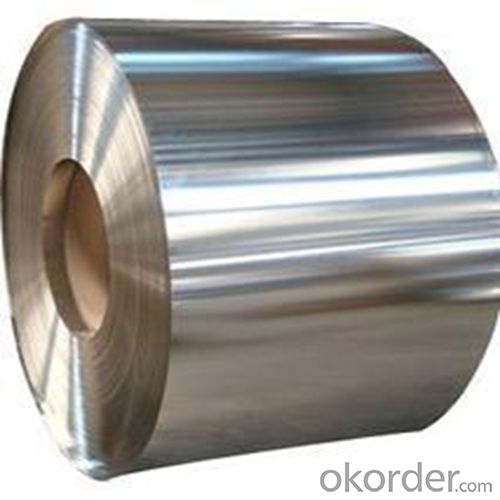

4.Electrolytic Tin Plate Coils and Sheets for Foods Metal Packaging Specification
Standard | ISO 11949 -1995, GB/T2520-2000,JIS G3303,ASTM A623, BS EN 10202
|
Material | MR,SPCC |
Thickness | 0.15mm - 0.50mm |
Width | 600mm -1150mm |
Temper | T1-T5 |
Annealing | BA & CA |
Coil Inner Diameter | 508mm |
Weight | 6-10 tons/coil 1~1.7 tons/sheets bundle |
Passivation | 311 |
Oil | DOS |
Surface | Finish,bright,stone,matte,silver |
5.FAQ of Electrolytic Tin Plate Coils and Sheets for Foods Metal Packaging
-What your tinplate material is used for ?
Tinplate is widely used for the packaging of products. Such as food cans,
beverage cans, pet cans, closures, general line cans and so on.
Printed Tinplate is offered!!
-How to place .an order or contact you ?
Please send us Email. we will give you a quick response in seconds .
- How is your quality ?
All our quality is prime even the secondary quality . We have many years experience
In this field with serious quality control standard . Advanced equipment, We welcome your visit to our factory .
- Q: Can tinplate be used for kitchenware?
- Yes, tinplate can be used for kitchenware. Tinplate is a type of steel coated with a thin layer of tin, which provides protection against corrosion and enhances its aesthetics. It is commonly used for making cans, containers, and other kitchen utensils like bowls, trays, and cooking pans. Tinplate is durable, easy to clean, and resistant to rust, making it suitable for various kitchen applications.
- Q: How is the thickness of tinplate measured?
- The thickness of tinplate is typically measured using a specialized instrument called a micrometer, which accurately measures the distance between the surfaces of the tin coating.
- Q: How to test the tightness of tin metal cans?
- The empty tank which has been cleaned can be dried by 35, and the pressure or pressure leak test shall be carried out according to the equipment condition of each unit. B.1 pressure leak test, the empty tank will be carefully injected into the water until eight or nine into full, the rubber ring will be placed in the appropriate plexiglass plate at the opening side of the roll, so that it can be sealed. Start the vacuum pump, turn off the bleeder valve, hold down the cover by hand, control the pumping, and make the vacuum gauge rise from 0Pa to 6.8X10 PA (510mmHg) for more than 1min, and keep the vacuum above 1min.
- Q: What are the different types of tinplate seams?
- There are three main types of tinplate seams: the lap seam, the double seam, and the triple seam. The lap seam is formed by overlapping the tinplate and soldering the edges together. The double seam involves folding the edges of the tinplate over each other and then crimping them together. Lastly, the triple seam is created by folding the edges of the tinplate over each other twice and crimping them together.
- Q: What are the main challenges in tinplate labeling?
- The main challenges in tinplate labeling include ensuring proper adhesion of labels to the smooth and sometimes oily surface of tinplate, maintaining label integrity during the packaging and transportation process, and finding solutions to prevent label damage due to moisture, heat, or other environmental factors. Additionally, accurately positioning and aligning labels on curved or irregularly shaped tinplate surfaces poses a significant challenge.
- Q: How is tinplate used in the production of aerosol valves?
- Tinplate is used in the production of aerosol valves as it provides a durable and corrosion-resistant material for the valve components. It helps to maintain the integrity of the valve, ensuring a reliable and leak-proof seal. Additionally, tinplate can be easily formed into intricate shapes, allowing for the precise design and functionality required in aerosol valves.
- Q: What are the main challenges in tinplate printing?
- The main challenges in tinplate printing include achieving accurate color reproduction, ensuring high-quality print resolution on a curved surface, maintaining adherence of ink to the metal substrate, and achieving consistent print registration on multiple colors. Additional challenges may include minimizing scratches or blemishes during the printing process and managing the overall production cost and time required for each tinplate print job.
- Q: How does tinplate packaging contribute to product tamper resistance?
- Tinplate packaging contributes to product tamper resistance by providing a strong and durable barrier that is difficult to breach without leaving visible signs of tampering. Its rigid nature and secure sealing mechanisms make it difficult for unauthorized access to the product, ensuring the integrity and safety of the contents. Additionally, tinplate packaging often includes tamper-evident features such as seals, breakable caps, or indicators that clearly show if the package has been opened or tampered with, providing a clear visual cue to the consumer.
- Q: Can tinplate be used for coinage?
- No, tinplate cannot be used for coinage as it is a thin sheet of steel coated with a layer of tin, which is not a suitable material for making coins.
- Q: What are the potential health risks associated with tinplate?
- Tinplate, which is a thin sheet of steel coated with a layer of tin, poses few direct health risks. However, if the tin coating gets damaged, it can potentially lead to the release of tin into food or beverages, which may have negative health effects. Prolonged exposure to high levels of tin can cause stomach and intestinal issues, such as nausea, vomiting, and diarrhea. It may also affect the liver, kidneys, and nervous system. While the chances of significant health risks from tinplate are relatively low, it is important to handle and store tin-coated products properly to minimize any potential health concerns.
Send your message to us
Tinplate Coils / Sheet for Foods Can Packaging
- Loading Port:
- Tianjin
- Payment Terms:
- TT OR LC
- Min Order Qty:
- 25 m.t
- Supply Capability:
- 7000 m.t/month
OKorder Service Pledge
OKorder Financial Service
Similar products
Hot products
Hot Searches
Related keywords
